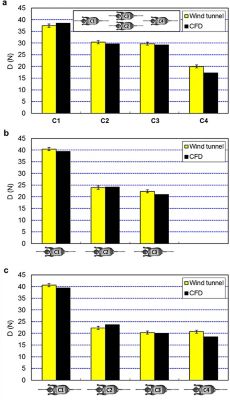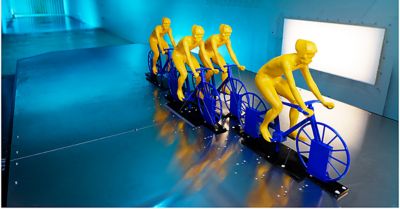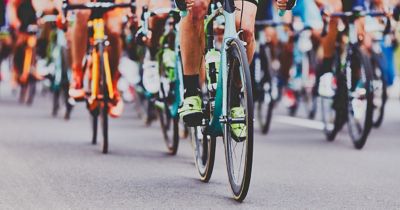-
-
Access Free Student Software
Ansys empowers the next generation of engineers
Students get free access to world-class simulation software.
-
Connect with Ansys Now!
Design your future
Connect with Ansys to explore how simulation can power your next breakthrough.
Countries & Regions
Free Trials
Products & Services
Learn
About
Back
Products & Services
Back
Learn
Ansys empowers the next generation of engineers
Students get free access to world-class simulation software.
Back
About
Design your future
Connect with Ansys to explore how simulation can power your next breakthrough.
Free Trials

This is especially problematic for team leaders, as losing ground can jeopardize the entire team’s strategy. To help preserve this cyclist’s energy, teammates will shield their team leader from the wind as he or she catches up to the peloton. But what configuration provides optimal wind coverage for the leader? As avid Tour de France fans, Professor Bert Blocken of Heriot-Watt University and his collaborators wanted to find out if they could use computational fluid dynamics (CFD) to quantify the benefits of different cycling formations.

High-resolution computational grid using the cyclist model developed by Heriot-Watt University and Ansys, part of Synopsys
Coming Out on Top
The Tour de France is not for the faint of heart. In the 2025 iteration of the world-famous race, cyclists covered over 3,000 kilometers — nearly 2,100 miles — over 23 days with a total elevation gain of 51,550 meters, or almost 170,000 feet. With climbs and summits in some of the most mountainous areas of France, riders need an unprecedented amount of physical and mental strength to come out on top.
Cycling may seem like an individual sport, but in reality, it heavily relies on teamwork. In the Tour de France, each of the 23 teams has eight cyclists who all play a crucial part in the overall success of the team. While each rider helps in different ways, the key to bringing the team leader back into the peloton is drafting. Teammates often form a paceline — a single file or staggered line — with their respective team leader sitting second to fifth in line. The goal of this strategy is to reduce drag for the leader by taking the brunt of the wind force.
“The main goal is to minimize the effort of the leader to preserve maximum energy for the rest of the race,” says Blocken. “Depending on the competitive situation, there will be the recruitment of one or more teammates to protect the leader as much as possible from the wind to reduce aerodynamic drag.”
Quantifying Formations With Simulation
Blocken and his collaborators published a study in which they investigated the effectiveness of different cyclist formations that shield the team leader from wind. Using a cyclist model developed by Heriot-Watt University and Ansys Fluent fluid simulation software, the team simulated the flow fields of wind around three, four, and five cyclists in varying formations. The researchers developed high-resolution computational grids with wall-adjacent cell sizes of 20 micrometers to resolve the important laminar sublayer at the cyclist and bicycle surfaces. The simulations were made with Fluent software using its advanced Transition SST k-w model in a pseudotransient formulation. In these simulations, they assumed there was no strong head, tail, or crosswind and that no in-race vehicles, such as cars or motorcycles, were present close to the cyclists. The results were then validated in a wind tunnel.
“We are bringing aerospace engineering technology to the Tour de France to help athletes better leverage their existing skills. But introducing artificial intelligence (AI) and numerical simulation into popular sports such as cycling is also an excellent way to show the importance of modeling and simulation to a wider audience and explain complex physics in a fun and simplified way,” says Thierry Marchal, program director, Sport and Healthcare at Ansys, part of Synopsys.
“The number of teammates required, and the configuration adopted to reduce the leader's effort without sacrificing too many team members, is usually determined by the current racing configurations and the feelings of the leader,” says Frédéric Grappe, head of performance and innovation at Equipe Groupama FDJ. “The ultimate goal is to bring the leader back into the group by smoothing out the effort as much as possible, avoiding accelerations as much as possible, which are very costly in terms of energy.”

Comparison of drag force (N) by wind tunnel measurements and computational fluid dynamics (CFD) simulations for three different cyclist formations
Contours of velocity ratio (left) and static pressure coefficient (right) for three-, four-, and five-cyclist formations. In the animations on the left, red represents high wind speed and green and blue represent low wind speed, or the slipstream. In the animations on the right, red is overpressure (resisting motion) while blue is under pressure (creating drag). The numbers on the cyclists’ bodies are the percentage of drag compared with a cyclist riding alone (= 100%).
For three riders in an inverted triangle formation, the trailing rider only experienced 39% drag. However, this greatly increased the drag for the front two riders. By adding a fourth rider and creating a diamond shape, the trailing rider experienced only 38% drag, and the leading riders also experienced significantly less drag. The most drag reduction for the leader was 24%, when two sets of two team members side by side were in front of him or her.
“This study examines numerous configurations and quantifies the advantages of each in the absence of crosswind, tailwind, and headwind. Despite other parameters such as different cyclist body geometries and the presence of other vehicles, this analysis provides invaluable information to discuss with our team before the race in order to agree on the best tactics,” says Grappe.
Learn more about how Fluent software can help solve aerodynamic and other fluid flow challenges across industries.
Just for you. We have some additional resources you may enjoy.
“We are bringing aerospace engineering technology to the Tour de France to help athletes better leverage their existing skills. But introducing artificial intelligence (AI) and numerical simulation into popular sports such as cycling is also an excellent way to show the importance of modeling and simulation to a wider audience and explain complex physics in a fun and simplified way.”
— Thierry Marchal, program director, Sport and Healthcare, Ansys, part of Synopsys
The Advantage Blog
The Ansys Advantage blog, featuring contributions from Ansys and other technology experts, keeps you updated on how Ansys simulation is powering innovation that drives human advancement.



